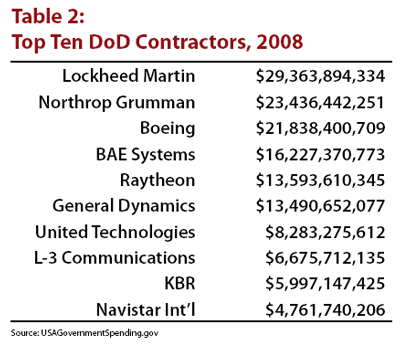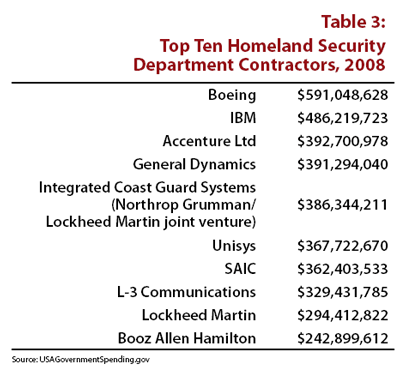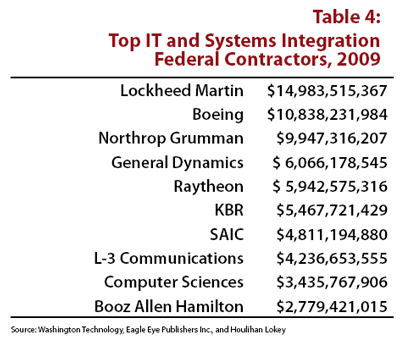
In his January 17, 1961 farewell address, President Dwight D. Eisenhower cautioned: "In the councils of government, we must guard against the acquisition of unwarranted influence, whether sought or unsought, by the military-industrial complex."
Five decades later, this complex, which Eisenhower defined as the "conjunction of an immense military establishment and a large arms industry," is no longer new. And while Eisenhower's warning is still pertinent, the scale, scope, and substance of the complex have changed in alarming ways. It has morphed into a new type of public-private partnership--one that spans military, intelligence, and homeland-security contracting, and might be better called a "national security complex."
Not counting the supplemental authorizations for the wars in Iraq and Afghanistan, current levels of military spending are, adjusting for inflation, about 45% higher than the military budget when Eisenhower left office. Including the Iraq and Afghanistan war budgets, military spending stands about 30% higher, adjusted for inflation, than any of the post-WWII highpoints--Korea, Vietnam, and the Reagan build-up in the 1980s. Private military contracting, which constituted about half of the Pentagon's spending in the 1960s, currently absorbs about 70% of the Department of Defense (DoD) budget. No longer centered exclusively in the Pentagon, outsourcing to private contractors now extends to all aspects of government. But since 2001, the major surge in federal outsourcing has occurred in the "intelligence community" and in the new Department of Homeland Security (DHS).
Since Sept. 11, 2001, a vastly broadened government-industry complex has emerged--one that brings together all aspects of national security. Several interrelated trends are responsible for its formation and explosive growth: 1) the dramatic growth in government outsourcing since the early 1990s, and particularly since the beginning of the George W. Bush administration, 2) the post-Sept. 11 focus on homeland security, 3) the wars in Iraq and Afghanistan, 4) the Bush-era surge in intelligence budget and intelligence contracts, and 5) the cross-agency focus on information and communications technology.
The term "military-industrial complex" no longer adequately describes the multi-headed monster that has emerged in our times. The industrial (that is, big business) part of the military-industrial complex has become ever more deeply integrated into government--no longer simply providing arms but also increasingly offering their services on the fronts of war and deep inside the halls of government--commissioned to carry out the very missions of the DoD, DHS, and intelligence agencies. In the national security complex, it is ever more difficult to determine what is private sector and what is public sector--and whose interests are being served.
Different Departments, Same Companies
In 2008, the federal government handed out contracts to the private sector totaling $525.5 billion--up from $209 billion in 2000. That's about a quarter of the entire federal budget. The DoD alone accounts for about $390 billion, or nearly three-quarters of total federal contracts.
The living symbol of the new national security complex is Lockheed Martin, whose slogan is "We Never Forget Who We're Working For." That's the U.S. government--sales to which account for more than 80% of the company's revenues, with most of the balance coming from international weapons sales and other security contracts facilitated by Washington. In addition to its sales of military hardware, Lockheed is the government's top provider of IT services and systems integration (see Table 1, below).
Whether it is military operations, interrogations, intelligence gathering, or homeland security, the country's "national security" apparatus is largely in the same hands. Various components of the U.S. national-security state are divvied up among different federal bureaucracies. But increasingly, the main components are finding a common home within corporate America. Corporations such as Lockheed Martin, Boeing, L-3 Communications, and Northrop Grumman have the entire business--military, intelligence, and "homeland security"--covered.
Lockheed Martin, Northrop Grumman, and Boeing led the top ten military contractors in 2008 (see Table 2).
The 2003 creation of the Department of Homeland Security has helped spawn an explosion of new companies, and new divisions of existing companies, providing "homeland security" products and services. Before President Bush created DHS in the wake of Sept. 11, the agencies that would be merged into the new department did very little outsourcing. From less than 1% of federal contracts (as a total dollar amount) in 2000, outsourcing by DHS has quadrupled as a portion of federal contracting from 2003 to 2009.

Although DHS contracts with scores of new companies, its top contractors are all leading military contractors that have established "homeland security" divisions and subsidiaries.
The top ten DHS contractors in 2008 were Lockheed Martin, Northrop Grumman, IBM, L-3 Communications, Unisys, SAIC, Boeing, Booz Allen Hamilton, General Electric, and Accenture, all leading military contractors. Other major military contractors among the top 25 DHS contractors include General Dynamics, Fluor, and Computer Sciences Corp (see Table 3).

There is no public list of corporations that contract for U.S. intelligence agencies. But based on company press releases and filings with the Securities and Exchange Commission, Tim Shorrock concludes in his new book Spies for Hire that the top five intelligence contractors are probably Lockheed Martin, Northrop Grumman, SAIC, General Dynamics, and L-3 Communications. Other major contractors include Booz Allen Hamilton, CACI International, DRS Technologies, and ManTech International, also leading military contractors.

Within the past eight years--since Sept. 11, 2001--the intelligence budget has soared, rising from an estimated $30 billion in 2000 to an estimated $66.5 billion today. Intelligence agencies have channeled most of the new funding to private contractors, both major companies like CACI and thousands of individual contractors. Private contracts now account for about 70% of the intelligence budget. Intelligence community sources told the Washington Post that private contractors constituted "a significant majority" of analysts working at the new National Counterterroism Center, which provides the White House with terrorism intelligence.
The major military contractors are now moving their headquarters from their production centers, often in California and Texas, to the Washington Beltway in pursuit of more intelligence, military, and homeland security contracts. The gleaming Beltway office buildings of the security corporations are now the most visible symbol of this national security complex.
Boots on the Ground, Computers in Cubicles
Another feature of this evolving, ever-expanding complex is that all the U.S. government departments involved in national security--DoD, State Department, DHS, and intelligence--are outsourcing the boots-on-the-ground components of their missions through the use of private security and military provider firms. Companies such as ArmourGroup (which includes Wackhenhut), DynCorp, MPRI, and Xe (formerly Blackwater Worldwide) have injected the private sector directly into the public sector through their work as interrogators, military trainers, prison guards, intelligence agents, and war-fighters.
Five dozen of these security contractors have organized themselves into the International Peace Operations Association (IPOA). After Blackwater came under worldwide scrutiny for its massacre of unarmed Iraqis in central Baghdad on Sept. 17, 2007, the firm left IPOA, whose code of conduct for "peacekeeping" operations it had flagrantly ignored. Blackwater created a new association of private military contractors called Global Peace and Security Operations--conveniently without any potentially embarrassing code of conduct.

Private contractors are not only on the frontlines of war and clandestine operations, but have also penetrated the national security bureaucracy itself. Reacting to a March 2008 GAO report on conflicts of interest within the Pentagon, Frida Berrigan of the New America Foundation's Arms and Security Initiative observed that alarming numbers of "cubicle mercenaries" are now working within federal bureaucracies as administrators, contract managers, intelligence analysts, and cybersecurity chiefs. No longer does the "large arms industry" that Eisenhower warned about just peddle goods like weapons and missiles, it also sells itself through its services.
Common Dominators of the New Complex: Information and Security
Private contractors are also in control of the core of the complex's information and intelligence systems. Information and communications technology is the fastest-growing sector in government contracting. The DHS's expanding involvement in cybersecurity, information systems, and electronic identification programs, for example, is adding billions of dollars annually to the national security boom.
Lockheed Martin led the ranks of information technology (IT) contractors in 2008, followed by Boeing and Northrop Grumman. Although IT contracts are expanding rapidly, there are few new entrants to the list of top IT providers to the government. Among the top 100 IT contractors, there were just twelve new entrants, as traditional military giants dominated the list (see Table 4).
One of the largest sources of federal contracting at DHS has been the EAGLE (Enterprise Acquisition Gateway for Leading Edge Solutions) IT program, which awarded $8.2 billion in contracts in the past three years. Among the leading contractors are CACI, Booz Allen Hamilton, Lockheed Martin, SAIC, Northrop Grumman, General Dynamics, and BAE Systems--all major military contractors. Most of the EAGLE IT bonanza is in the form of "indefinite-delivery, indefinite quantity contracts" that provide generous operating room for IT firms to determine their own solutions to DHS' vast IT and cybersecurity requirements.
The major military corporations have quickly formed new branches to focus on these new opportunities outside of their traditional core contracts with the Pentagon. This year, for example, Northrop Grumman created a new Information Systems division to seek military, homeland security, and intelligence IT contracts. Recognizing the interest in the Obama administration in cyber-security and information war, corporations such as Booz Allen Hamilton and Hewlett-Packard, among others, have created new cybersecurity divisions or subsidiaries. Similarly, the new administration's focus on transnational disease has led military companies such as General Dynamics to acquire medical subsidiaries.
Revolving-Door Security Consultants
Another manifestation of the new national security complex is the rise of a new series of consulting agencies that act as an interface between government and their clients. That's an easy connection for such companies as the Chertoff Group, Ridge Global, and RiceHadley Group, since all their principals recently left government, where they had presided over the unprecedented wave of outsourcing.
Two of these national security agencies are headed by the DHS's first two secretaries, Michael Chertoff and Tom Ridge, while the newest group brings together Condoleezza Rice and Stephen Hadley, who only a year ago were serving as secretary of state and national security adviser, respectively.
When announcing his group's formation, Chertoff boasted, "Our principals have worked closely together for years, as leaders of the Department of Defense, the Department of Homeland Security, the Department of Justice, the National Security Agency and the CIA." Indeed, a leading member of this new group is former CIA director Michael Hayden (2005-2009), who also directed the National Security Agency (1999-2005). Others include former DHS deputy Paul Schneider (who was head of acquisitions for NSA and the U.S. Navy prior to his position at DHS); Admiral Jay Cohen (Ret.), who was DHS director of science and technology and previously the Navy's technology chief; and Charlie Allen, who was the intelligence chief at DHS and, according to Michael Chertoff, "pretty much head of everything you could be for the CIA."
The Chertoff Group has now hooked up with Blue Star Capital, a transatlantic investment company specializing in mergers and acquisitions in the security business. In its announcement of the new partnership, Blue Star emphasized their joint interest in "generating opportunities" across the national security spectrum--"in the homeland security, defense, and intelligence markets."
Chertoff himself applauded the value of the merger: "I believe there are many areas of opportunity within the Homeland Security, Intelligence and Defense sectors where the synergies between Blue Star and the Chertoff Group will provide real value."
Taking Back Security
The "unwarranted influence" that concerned Eisenhower during the Cold War now pervades national politics and is rarely questioned. Nor has there been any evaluation of the achievements of the increasingly privatized national security complex. In his 2010 State of the Union address, President Obama talked about the need for fiscal restraint, but exempted "national security" from the planned spending freeze. Despite manifold evidence of vast waste and scandalous profiteering in the security apparatus--to say nothing of "unnecessary wars"--the president didn't see fit to scale back the security agencies. By failing to do so, he has all but guaranteed that the outsourcing bonanza will continue. With "national security" off limits for budget cuts, Obama signaled that safeguarding the nation against the "unwarranted influence" and "rise of misplaced power" will not be priorities for this administration.
As major corporations such as Lockheed Martin and security consulting agencies such as the Chertoff Group extend their corporate tentacles into the intelligence, military, and homeland security terrains, the greater threat they pose. The corporate penetration of all the government's information-gathering, communications, intelligence, and data systems undermines democratic governance. The new corporate domination of data-mining, communications, and cybersecurity systems--with little or no government oversight --threatens individual liberty and privacy. This also creates a powerful vested interest in a large and growing "national security" apparatus--and one that is deeply integrated with the top echelons of the intelligence agencies, military, and other parts of this secretive state-within-the-state.
In the end, it's not the contractors that are the central problem with the national security complex--it's the outsourcers, that is, the elected politicians and the government administrators they appoint or confirm. The contractors are working to maximize profits, and are answerable mainly to company shareholders. The outsourcers, however, are ultimately answerable, at least in principle, to the public. What is at stake is who really controls public policy--a democratically accountable government, or an unaccountable fusion of governmental and corporate power.
